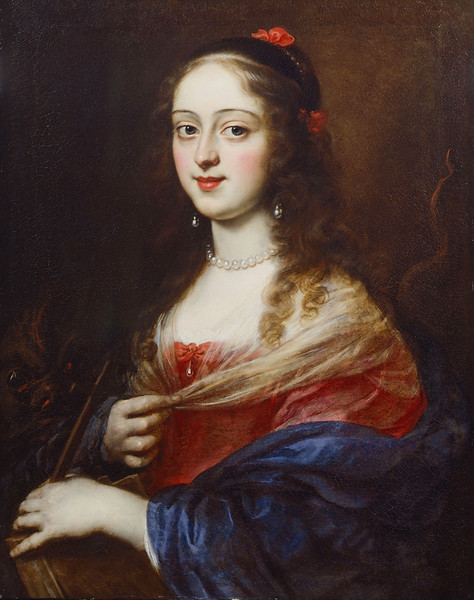FG FINE ART LTD

Giusto Suttermans
Antwerp, 1597 - Florence, 1681
The practice of depicting members of the Medici family as saints began in the second half of the 16th century. This tradition was first seen when the face of Pope Clement VII appeared in a portrayal of Gregory the Great in the Church of San Michele in Bosco in Bologna, as well as in a depiction of Saint Donatus, the bishop, in a Deposition scene in the church of the Eremo di Camaldoli. Following these, two small panels depicting Saints Cosmas and Damian in Palazzo Vecchio were created, with these saints portrayed as Cosimo the Elder and Cosimo I, the Grand Duke. However, in the 17th century, it was the women of the Medici family who favoured this form of portraiture. The first of these was Maria Magdalena of Austria, wife of Cosimo II, but it was with Vittoria della Rovere, wife of Ferdinando II, that we see the most numerous examples of this type of representation.

Portrait of the Grand Duchess Vittoria della Rovere as Saint Margaret of Antioch
Oil on canvas, 67 x 53 cm
Provenance
Private Collection
Bibliography
S. Bellesi, Catalogo dei pittori fiorentini del ‘600 e ‘700. Biografie e opere, Florence 2009, Vol. I, pp. 43 LIV, 256
Within this portrait, we recognize the features of the still handsome Grand Duchess Vittoria della Rovere (1622-1695), depicted at half-length while turning her idealized gaze towards the viewer. The sole accessories added to the simple apparel of this young woman are the pearls around her neck, on her ears, in her hair and at her breasts, each most probably alluding to her purity and chastity.
Sutterman’s portraiture style is shaped by the pictorial material of the light complexion, the construction of the eyes, the affected mouth and a faint smile and her laid hands, all elements easily traced in this artist’s production
The attributes of the book, the cross and the dragon all work to identify Vittoria as Saint Margaret of Antioch. This personification probably has a precise, votive meaning, hoping for the subject’s safety for a future childbirth. This is further shown by the book’s position supporting the pregnant woman’s belly, making an explicit reference to the life of the saint. An addition to the hagiographic tradition inserted by Jacobus de Voragine in his chapter on Saint Margaret (“Margaret also asked God to save every woman in labour who sought her help”) was to assign her the role of protector of pregnant women and those giving birth.
If, as seems likely, this hypothesis is correct, the most probably date for the canvas is around 1639, when the Grand Duchess, after having celebrated her marriage to Ferdinando II de’ Medici in April of 1637, had two pregnancies which she failed to carry to term. After a third pregnancy failed in 1641, in 1642 Vittoria gave birth to the future Cosimo III and in 1660 she became a mother yet again with Francesco Maria.


In this period, the representation of Medici family members as saints became a powerful visual tool, not just for commemorating religious figures, but for asserting the family's authority, piety, and divine favor. The choice to embody family members as saints, especially during the 16th and 17th centuries, reflects the Medici's understanding of the importance of religious and political imagery in reinforcing their status.
The year 1639 as terminus ante quem for the canvas appears as the most likely because it is compatible with the apparent age of the Grand Duchess, who was born in 1622 and, therefore, would be portrayed here just before she reached twenty years old. This is both because it is in harmony with the pictorial style adopted by Giusto Suttermans in the mid-thirties who is, most evidently, the author of the portrait examined here.
Both in the hairstyle and in the young woman’s shape we can detect the young painter’s typical taste for detail. The dress shows a faster movement and a chromatic brilliance that certifies that Suttermans had studied the large picture by Rubens dedicated to the Consequences of War, now in the Galleria Palatina in Florence, which the painter sent to his colleague in 1638. The painting was accompanied by a letter in which Rubens expresses to Suttermans a sincere appreciation of his work, shared, it is worth remembering, with the other great Flemish painter, Anthony Van Dyck.
Suttermans, according to documents in the Medici archives, painted at least seventeen portraits of Vittoria della Rovere, by virtue of the role of official portrait painter to the Medici court, which he held for over sixty years, from his arrival in Florence in autumn 1620, until his death in 1681. Among these, the most successful is undoubtedly the one which always portrays her as Saint Margaret taken from the Guardaroba to Galleria Palatina. His long career, during which he did not produce altar paintings and only some rare religious and genre scenes, was almost exclusively in the Florentine court, apart from a significant stay in Rome, completed in 1627, to portray Pope Urban VIII, his family and several cardinals, and requests to the Medici for use of their court painter from the sister nations of Modena, Mantua, Ferrara, Parma, Innsbruck and Vienna.
After the dependable biography dedicated to the painter from his roughly contemporary friend, Filippo Baldinucci, to have an initial and critical framing of his personality, then you must wait until the beginning of the Novecento with the first monograph by Bautier. Towards the end of the last century, the painter has been a subject of an exhibition that was fundamental for the understanding of his works; he was then well-represented in the exhibition the Florentine ‘600 century held in 1986 at Palazzo Strozzi
A full fact sheet is available on request.